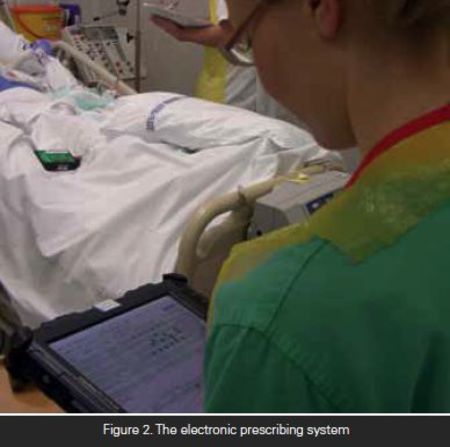HealthManagement, Volume 7 - Issue 1, 2012 HIT
The healthcare sector is subject to great technological change in an effort to improve current practice and patient safety. While the use of information technology has been encouraged as a solution to improve patient safety and reduce medication errors, appropriate methods must be applied to the design and development of such systems to ensure they are usable. An interdisciplinary team, comprising experts both in interactive systems and healthcare design and consultant anaesthetists, nurses, and pharmacists, was formed and authentically participated in the design and development of an electronic prescribing and administration system tested in the ICU at Ninewells Hospital, Dundee.
Introduction
Information Technology has been encouraged as a solution to improve patient safety. However, there is a lack of evidence about the impact of information technology in the healthcare sector with many healthcare systems under evaluated. Although there is potential for the introduction of information technology to improve healthcare, badly designed systems can compromise patient safety. Usability problems have been found to frustrate end-users and have an adverse impact on patient care. The focus of this project was to facilitate safer medication prescribing within intensive care through the use of electronic systems, aiming to create a usable system, which reduces the likelihood of non-compliant prescriptions.
Interdisciplinary Working
There is often a tendency to work in parallel in multidisciplinary projects that link the computing and medical domains. To overcome the silo approach and to guarantee interdisciplinary collaboration, a project team was formed at the outset of the project, consisting of clinicians from Ninewells Hospital, Dundee and a group from the School of Computing, University of Dundee. Prior to forming the team, a lead clinician at Ninewells Hospital Intensive Care Unit (ICU) had identified a need for creating an electronic prescribing system and approached the University of Dundee about a possible collaboration. The involvement of the senior clinician facilitated the recruitment of clinicians to the project team.
The team comprised two consultants in anaesthesia and intensive care, the principal clinical pharmacist for critical care, the intensive care specialist liaison nurse, a nursing education specialist, a professor of interactive systems design, a professor of assistive systems and healthcare computing and a PhD student. Some of the individuals on the team changed during the threeyear period but the professional composition was unaffected.
System Development
The multidisciplinary team were engaged and involved in the design and development of the prototype electronic prescribing and administration system. The interface was designed to actively enhance the compliance of medical prescribing, be highly usable and not have a negative impact on patient care. The main advantage of the paper medication chart used in Ninewells ICU was its accessibility; it could be accessed by nurses, doctors and pharmacists and could be viewed by multiple users simultaneously. The electronic system needed to replicate this and also be portable to prevent restricting the normal interaction process that was observed with the paper system e.g. nurses taking the paper chart to the doctor if they had a query about a prescription or passing the chart between the team in the morning ward round. This led to the decision to use a tablet PC.
The system was designed as a client server application, allowing several client machines to be connected to the server, providing each patient with a tablet machine, a tablet stylus for input and an incorporated barcode scanner to allow users to log on to the system. The tablet PC could be mounted at the end of the patients’ bed to provide easy viewing and be easily removed from the mount. It was roughly the same size as the paper chart. A rugged tablet PC was required to survive the Intensive Care environment, enduring extensive cleaning and being dropped. A tablet stylus was used for input instead of a keyboard for portability and to further reduce the risk of infection.
The electronic prescribing and administration system was intended to emulate the original paper medication chart with the additional functionality of confirming that medication had been administered (which was previously recorded on the paper Medicine Recording Sheet). The interface was organised into two sections, similar to the paper system, with the top section displaying regular prescriptions and the bottom section displaying the “once only” prescriptions. Within the regular prescription section three subsections displayed “discontinued”, “current” and “future” prescriptions.
Within the regular prescriptions, continuous infusions were grouped together as a result of nursing staff feedback to make the administration process easier and to reflect the sequence for administering medication. The interface was designed to minimise free text input, to avoid frustration and save time entering text via an onscreen keyboard.
Evaluation
An evaluation of the electronic prescribing and administration system was conducted in a clinical setting over a sustained period to identify the extent to which:
1. The electronic prescribing and administration system had an effect on levels of non-compliant prescriptions prevalent in the ICU.
2. Users found the electronic prescribing and administration system usable.
The system was evaluated without the experimenter being present and over a prolonged period, to reduce the risk of any Hawthorne or novelty effects. The absence of the experimenter eliminated any pressure to use the system, indicative of the level of enthusiasm amongst users. The electronic prescribing and administration system was introduced into the ICU, Ninewells Hospital over a five-month period (14th January – 5th June 2008), and tested on 16 patients. Paper and electronic prescription charts were run in parallel on the ward. To measure the effectiveness of the electronic prescribing system, deviations made in the prescribing process were compared using the two different systems: The electronic prescription and administration system and the paper prescription chart, for 16 different patients over the five-month period. A retrospective review was conducted where both types of chart were checked against 15 standards for prescription compliance derived from the Safe and Secure Handling of Medicines Policy.
To evaluate the clinicians’ perceptions of the electronic prescribing system, qualitative methods were used to collate feedback. From a total population of 62 clinicians who had used the system, a sample was interviewed, comprising nine doctors, ten nurses and a clinical pharmacist.
Evaluation Results
The electronic prescribing and administration system almost doubled the level of prescription compliance (from 46.73 percent with the paper system to 91.67 percent with the electronic) and significantly reduced prescribing deviations (from 51 to 8.5 percent).
The results of the interviews demonstrated that overall the electronic system was preferred.
“(I prefer the electronic system) because it’s made life a bit easier from our point in administering drugs to be able to read straight away what’s been happening” (Staff nurse)
“One thing is it’s definitely safe, … Patient safety - I think it’s immensely improved and the other thing is it’s very legible... and everybody can understand what’s happening very clearly” (Specialist registrar)
The users’ experience was on the whole positive. Generally they found the system intuitive, easy to learn and they were comfortable using it.
Conclusion
Previous studies have shown that inappropriate designs can lead to the introduction of errors or to systems, which are not viewed positively by the users. There was no evidence of these issues in the Ninewells study, demonstrating the importance of involving clinicians in the design and development of an electronic system to produce an effective and workable solution, in this case an interface that successfully improved the compliance of the medication prescribing process.
Future Work
The approach taken to create a usable electronic prescribing and administration system, which enhanced compliance with the medical prescribing process, may be capable of wider application in other healthcare application areas. Funding has been secured, in collaboration with NHS Tayside and Knowledge Transfer Partnership to take a user-centered approach to the design and development of an IT system in the surgical high dependency unit (SHDU). The system will enable real-time data to be entered on certain healthcare processes, the environment in which these processes are occurring, and the outcomes from these processes whilst providing real-time feedback on this information to enable early intervention if a problem is identified.






















